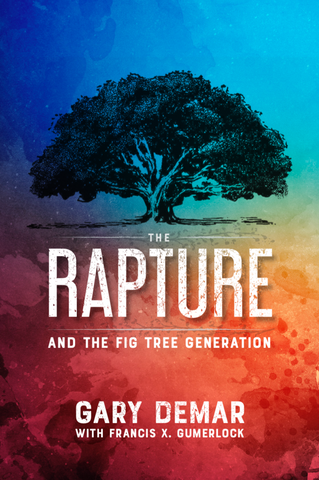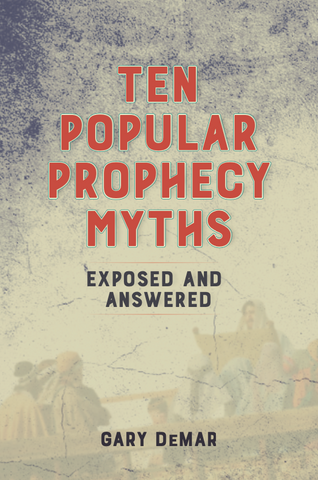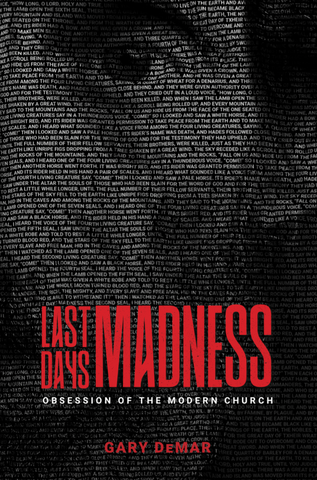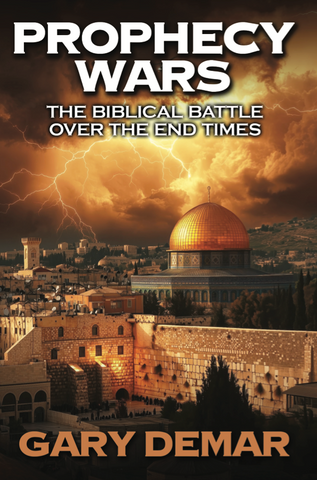I received the following from a listener to one of my podcasts:
I started to listen to the podcasts of Mr. DeMar. In the one regarding will the 3rd Temple be rebuilt, he states there is nothing in the New Testament mentioning one will be rebuilt. That, I believe, is not true.
He mentions Daniel’s 70 weeks, 2 Thessalonians 2, and Revelation 11:1. He then states, “To me this is very clear that a 3rd temple has to be rebuilt. If you don’t agree, please let me know what these verses are referring to.”
Let’s start with Daniel’s 70 weeks-of-years prophecy. There is no place in Scripture where a set number of days, weeks, or years includes a separating gap. There is no stated gap between the 69th and 70th weeks just like there is no separating gap between the 7 and 62 (Dan. 9:25). The number 70 follows 69. Notice how Daniel 9 begins.
In the first year of Darius the son of Ahasuerus, of Median descent, who was made king over the kingdom of the Chaldeans—in the first year of his reign, I, Daniel, observed in the books the number of the years which was revealed as the word of the LORD to Jeremiah the prophet for the completion of the desolations of Jerusalem, namely, seventy years. (vv. 1-2).
Was there a gap between the 69th and 70th years? No. The 70th year followed the 69th year. Jesus was crucified (cut off) in the middle of the 70th week. The final 3.5 years ends when Stephen outlines Israel’s history and ends his speech with the following.
“You men who are stiff-necked and uncircumcised in heart and ears are always resisting the Holy Spirit; you are doing just as your fathers did. Which one of the prophets did your fathers not persecute? They killed those who had previously announced the coming of the Righteous One, and you have now become betrayers and murderers of Him; you who received the Law as ordained by angels, and yet did not keep it.” (Acts 7:51-53; see Matt. 23:29-36)
That event ends the 70 weeks-of-years prophecy. There is no mention of the antichrist in Daniel 9:24-27. It’s about Jesus, “Messiah the Prince” (9:25). Jesus is the “the prince who is to come [who] will destroy the city and the sanctuary. And its end will come with a flood; even to the end there will be war; desolations are determined.” (9:26) Jesus predicts this in Matthew 23:37-39. Jesus outlines what was going to happen to their generation before it passed away (Matt. 24:1-34), which included the destruction of the temple in 24:2. The temple was destroyed just like Jesus predicted it would be. Josephus, an eyewitness to the events surrounding Jerusalem’s history, wrote The Wars of the Jews about Israel’s war with Rome.
Nothing is said about a so-called “rapture of the church” that will take place before (pre-trib), during (mid-trib), before God’s wrath is poured out (pre-wrath), or after (post-trib) seven years. See my book with Frank Gumerlock The Rapture and the Fig-Tree Generation.

The Rapture and the Fig Tree Generation
Since the national reestablishment of Israel in 1948, countless books and pamphlets have been written defending the doctrine assuring readers that it could happen at any moment. Some prophecy writers claimed the “rapture” would take place before 1988. We are far removed from that date. Where are we in God’s prophetic timetable?
Buy NowWhile the NT describes the temple’s destruction, there is no verse that says the temple will be rebuilt. Jesus is the permanent temple (John 2:13-22), “a living stone, rejected by men,” and we are “living stones being built up as a spiritual house for a holy priesthood…” (1 Pet. 2:4). The stone temple (“not one stone here shall be left on another, which will not be torn down” [Matt. 24:2]) was a type of the true temple. Nowhere does any NT writer even intimate that there will be another temple. For what purpose? So God can turn over everything to the “antichrist” (see the biblical definition of antichrists who were alive in John’s day: 1 John 2:18, 22; 4:1-4; 2 John 2:7) and allow him to end up slaughtering millions of Jews living in Israel based on Zechariah 13:7-9? For more information on the rebuilt temple claim, see chapter 7 in my book Ten Popular Prophecy Myths Exposed and Answered.

Ten Popular Prophecy Myths Exposed and Answered
Millions of books have been sold proclaiming countless false prophecies. Many Christians are beginning to take a second look at the biblical prophetic record. A seismic shift in biblical eschatology is taking place around the world because Christians, some for the first time, are willing to challenge what they have been taught based on what the Bible actually says.
Buy NowWith this background out of the way, what is Paul describing in 2 Thessalonians 2:1-4? The temple was still standing when Paul wrote to the Thessalonians. The man of lawlessness was alive in Paul’s day: “you know what restrains him now.” (2 Thess. 2:6). The “now” was then. The “mystery of lawlessness” was “already at work.” (v. 7). It’s important to note that some Thessalonians were under the impression that the “day of the Lord has come.”[1] v. 2. If this was either the rapture or the second coming, how could they have thought either event had happened since no one had been “raptured” and Jesus had not returned physically? How could Paul have written a letter telling them that either event had happened since he would not be on earth to write such a letter? You must assume Paul is describing a rebuilt temple of which there is no biblical evidence. Whover the man of lawlessness was (and there are several theories), he took his eat in the temple that had been completed around AD 64, and he was destroyed when Jesus returned to destroy the temple. I cover 2 Thessalonians 2 in two chapters of my book Last Days Madness.

Last Days Madness
In this authoritative book, Gary DeMar clears the haze of "end-times" fever, shedding light on the most difficult and studied prophetic passages in the Bible, including Daniel 7:13-14; 9:24-27; Matt. 16:27-28; 24-25; Thess. 2; 2 Peter 3:3-13, and clearly explaining a host of other controversial topics.
Buy NowAlso, I’ve included Johann Christian Schoettgen’s Commentary on 2 Thessalonians 2 in my book Prophecy Wars.

Prophecy Wars: The Biblical Battle Over the End Times
If you’re willing to take the Bible at its word, the study of prophecy can strengthen your faith, but if your trust is in man’s speculations, you will be disappointed every time. And that is why Bible prophecy is such a crucial area for apologetics. Skeptics of all stripes have condemned the Bible as inaccurate merely because various well-meaning Christians have been in error about the End Times.
Buy NowThere was an apostasia, a falling away. These were the antichrists John mentioned.
Children, it is the last hour; and just as you heard that antichrist is coming, even now many antichrists have appeared; from this we know that it is the last hour. They went out from us, but they were not really of us; for if they had been of us, they would have remained with us; but they went out, so that it would be evident that they all are not of us…. Who is the liar except the one who denies that Jesus is the Christ? This is the antichrist, the one who denies the Father and the Son. (1 John 2:18-22)
The Greek word apostasia can mean a departure from the faith or a political rebellion. In theological terms, Jews who had professed Christ were returning to the old covenant. Hebrews and Galatians mentions this form of apostasia. Also, “Times of severe persecution are typically accompanied by men falling away from the faith, so this heavy tribulation implies [2 Thess. 1:4-7; 2:14-15], at very least, an occasion for apostasy. This tribulation is the very reason that Paul penned the first portion of the second chapter.”[2] Thessalonica was a hotbed of Jewish opposition to Christianity. (Acts 17:1-11) A political apostasia would refer to events surrounding the Jewish revolt against Rome (AD 66-70). The Jerusalem Bible translates apostasia as “revolt,” while the NIV, ESV, and NET translate it as “rebellion.”
Who “sits” in the temple and like the papacy speaks for God? “The Scribes and the Pharisees have seated themselves in the chair of Moses.” (Matt. 23:2) As long as they followed Moses, they were to be honored (Acts 23:2-5), but when they did not, they nullified the word of God by their traditions. (Mark 7:1-13). It’s no wonder that the Reformers claimed the “man of lawlessness” was the papacy. It’s most likely that the man of lawless was someone associated with the priesthood, the high priest who was blaspheming because he and those who followed him were the antichrists and by reviving the temple and their sacrifices they were profoundly and publicly denouncing Jesus as the fulfillment of the covenant promises. God destroyed them “with the breath of His mouth” that would bring that “lawless one … to an end by the appearance of His coming” (2 Thess. 2:8; see Isa. 11:4) in judgment in AD 70 (see Matt. 24:33-34).
The events of Revelation were “soon to take place … because the time was near.” Rev. 1:1; 3; 22:6, 10). John was a “fellow partaker in the tribulation” (1:9). John could measure the temple because it was still standing, which is evidence that Revelation was written before the temple’s destruction. See Kennth Gentry’s book Before Jerusalem Fell: Dating the Book of Revelation and his two-volume commentary on Revelation The Divorce of Israel. The temple had been “given to the Gentiles [Roman armies] for 42 months.” Henry Cowles (1803-1881), in his commentary on Revelation, offers the following:
[H]ere is one of the landmarks of our prophetic interpretation. We know that the temple, altar and holy city were standing at the time of this vision; we know they were on the very eve of their desolation; we know therefore that this desolation—so “shortly” after these visions were seen and recorded—can not possibly be any other than that effected by the Roman armies in A. D. 70.
The following is from Milton Terry’s book Biblical Hermeneutics:
“The statement of Luke xxi, 24, that ‘Jerusalem shall be trodden down by the Gentiles until the time of the Gentiles be fulfilled,’ is supposed to involve events which did not take place in that generation. The ‘times of the Gentiles’ (kairoi ethnown) are assumed to be the times of the opportunities of grace afforded to the Gentiles under the Gospel. But to understand the words in this sense would be, as Van Oosterzee observes, to interpolate a thought entirely foreign to the context. ‘The times of the Gentiles,’ says Bengel, ‘are the times allotted to the Gentiles to tread down the city;’ but there is nothing in the passage or context to authorize his further remark that ‘these times shall be ended when the Gentiles’ conversion shall be fully consummated,’ and that the treading down by Romans, Persians, Saracens, Franks, and Turks is to be understood. These kairoi [times] are manifestly times of judgment upon Jerusalem, not times of salvation to the Gentiles. The most natural and obvious parallel is Rev. xi. 2, where the outer court of the temple is said to be ‘given to the Gentiles,’ by whom the holy city shall be trodden down forty-two months, a period equivalent to the ‘time and times and half a time’ of Rev. xii, 14, and of Dan. vii, 25; xii, 7. This is a symbolical period of judgment (see above, p. 384 [in Biblical Hermeneutics], but does not denote ages and generations. It is three and a half—a divided seven, a short but signal period of woe. The ‘times of the Gentiles,’ therefore, are the three and a half times (approximating three and a half years) during which the Gentile armies besieged and trampled down Jerusalem.”[3]
Based on Scripture, it is clear the NT does not say another temple will be built, and theologically there is no need for another temple to be rebuilt.
[1] The KJV has “was near.” The Greek word ἐνίστημι is used and means “present.” The Greek word for “near” is not used.
[2] Lee W. Brainard, Apostasia in 2 Thessalonians 2:2: Rapture or Apostasy? (South Keep Press, 2021), 56.
[3] Milton S. Terry, Biblical Hermeneutics, unabridged ed. (Grand Rapids, MI: Zondervan, n.d.), 445.

